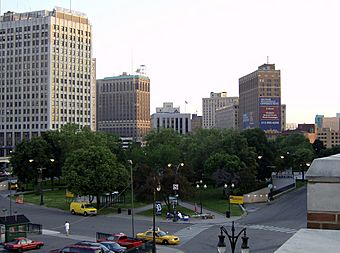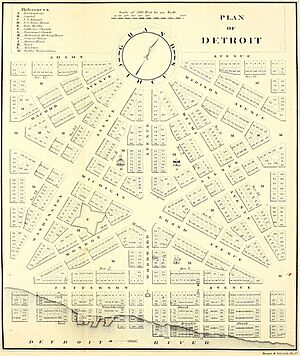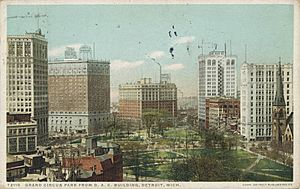Grand Circus Park Historic District facts for kids
Quick facts for kids |
|
|
Grand Circus Park Historic District
|
|

Looking southwest
|
|
| Location | Detroit, Michigan, U.S. |
|---|---|
| Built | 1867 |
| NRHP reference No. | 83000894; 00001488 (boundary increase) |
| Added to NRHP | February 28, 1983; December 07, 2000 (boundary increase); December 12, 2012 (additional documentation approved) |
The Grand Circus Park Historic District is a special area in Downtown Detroit, Michigan. It includes the beautiful Grand Circus Park, which is about 5 acres big. This park connects Detroit's lively theatre district with its busy financial district. The park is cut in half by Woodward Avenue, a main street in the city. It's located about four blocks north of Campus Martius Park. The area was officially recognized as a historic place in 1983.
Contents
History of Grand Circus Park
Grand Circus Park was part of a big plan to rebuild Detroit after a huge fire in 1805. A man named Augustus Woodward designed the city's new layout. The city officially created the park in 1850. Woodward's original idea was for the park to be a full circle. However, land prices went up, and property owners didn't want to sell their land north of Adams Street. This is why the park ended up being a half-circle shape.
The Detroit Opera House stands proudly overlooking the eastern side of the park. The park grounds are decorated with statues and large fountains. Near this historic spot, General George Armstrong Custer gave a speech. He spoke to thousands of people who had gathered to remember President Abraham Lincoln after his death.
Famous Sculptures and Fountains
The Russell Alger Memorial Fountain is a beautiful feature in Grand Circus Park. It was designed by architect Henry Bacon in 1921. Bacon also designed the famous Lincoln Memorial in Washington, D.C.. The Alger Fountain has a classic Roman figure that represents Michigan. This figure was sculpted by a famous American artist named Daniel Chester French. He also sculpted the figure of Lincoln for the Lincoln Memorial.
In 1957, the City of Detroit built a parking garage under both halves of the park. The eastern part can hold 250 cars, and the western part can hold 540 cars.
The half-moon shaped park is split down the middle by Woodward Avenue. This is one of the city's main roads. The Alger Fountain is a key feature on the eastern side. At its northern edge, there is a statue of former mayor William Cotter Maybury. The western half of the park has the Edison Fountain. At its northern edge, there is a statue of former mayor Hazen Pingree.
Moving Statues
The statues of Mayor Maybury and Mayor Pingree have been moved several times. The Pingree statue was first put up in 1904. It was near Woodward and Park Avenues, facing south. His rival, Maybury, was on the eastern side of the park, facing Pingree across Woodward Avenue.
After the parking garage was built in 1957, Pingree was put back in his original spot. But Maybury was placed at the north edge of the park, with his back to Pingree. In the 1990s, both statues were moved again to where they are now.
Buildings Around the Park
Many important buildings surround Grand Circus Park. On the south side, you can see the David Broderick Tower and the David Whitney Building. On the north side are the Kales Building and the Central United Methodist Church. To the east, you'll find Comerica Park and the Detroit Opera House.
Park Development
On November 12, 2007, a company called Quicken Loans announced big plans. They decided to move their main office to downtown Detroit. This meant about 4,000 employees would move from the suburbs to the city. This was a very important step for city planners. They wanted to bring new life back to the historic downtown area.
The development plans included the spots where the old Statler and Tuller hotels used to be. These hotels were once on the western edge of Grand Circus Park. The park area is also served by the Detroit People Mover, which has a station there.
East Necklace Area
The Detroit Opera House is located where Broadway and Grand Circus meet. The "east necklace" is a part of downtown that connects Grand Circus Park and the stadium area to Greektown. This area is along Broadway.
The east necklace includes a smaller area called the Harmonie Park District. This district is famous for Detroit's music history, from the 1930s to today. Near the Detroit Opera House, and spreading out from Grand Circus Park, are other fun places. These include the Music Hall Center for the Performing Arts and the Gem Theatre and Century Club. The historic Harmonie Club and Harmonie Centre are also along Broadway.
The Harmonie Park area ends near Gratiot and Randolph streets. The Detroit Athletic Club can be seen from Comerica Park's center field. This area has many cool buildings that are being updated into homes. One example is the Gothic Revival Metropolitan Building. The Hilton Garden Inn is also in the Harmonie Park area. The east necklace area is served by the People Mover at the Cadillac and Broadway Stations.
Gallery
-
Hazen S. Pingree Monument
-
Russell Alger Memorial Fountain is the only Daniel Chester French work in Detroit
-
Central United Methodist Church, in Victorian gothic style, overlooks Grand Circus Park
-
Cheli's Chili Bar on West Adams Street overlooking Comerica Park
See also
 In Spanish: Distrito Histórico de Grand Circus Park para niños
In Spanish: Distrito Histórico de Grand Circus Park para niños














